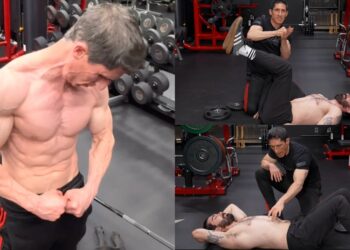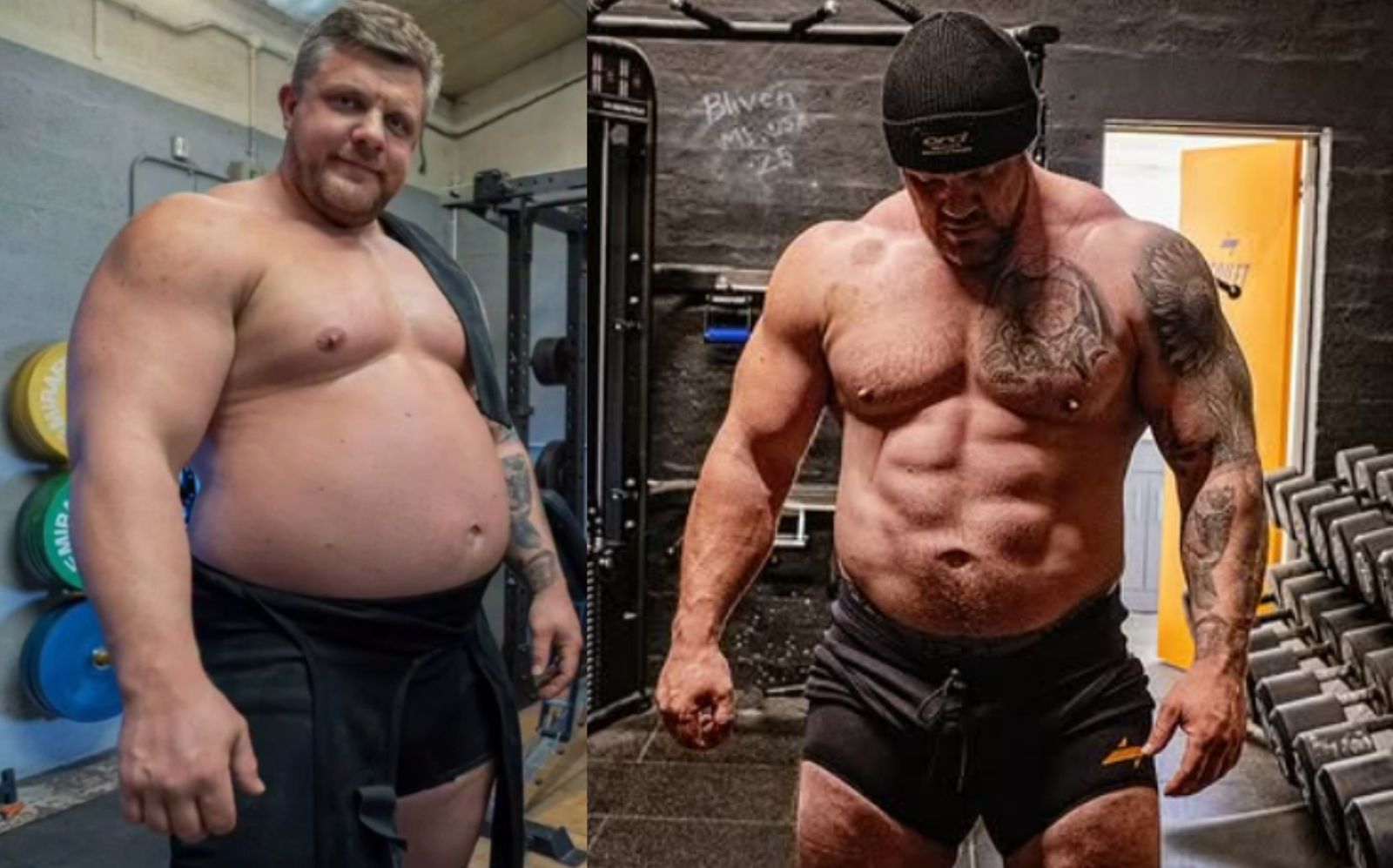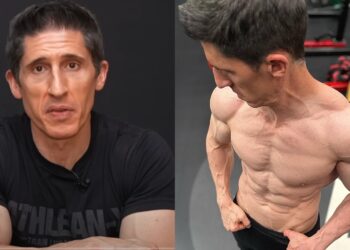As a veteran personal trainer with more than 30 years of experience, I’ve heard all the common diet and exercise myths. Some of the most popular include:
- Strength training makes women masculine
- Eating fat makes you fat
- The more you sweat, the better your workout
- Soreness is an indicator of muscle growth
- Resistance machines are safer than free weights
- Cardio is the best way to burn fat
Related: 6 False Positives of Effective Workouts
In most cases, these myths are not only debunked by science but by common sense, too. Enough people have tried (and failed) that the proof, as they say, is in the pudding.
However, there is one myth that may not be a myth at all—spot reduction. Despite research suggesting that high-rep, high-volume abs training has no impact on abdominal fat, many people still feel that it works.
As a kid, I read about a bodybuilder who trained abs in a way that stuck with me. He’d do regular crunches for the entire first side of his favorite LP, then switch to twisting crunches for side B. That totaled about 40 minutes of nonstop abs work—and his midsection was shredded!
It seemed, to me at least, that spot reduction had some merit.
Level Up Your Fitness: Join our 💪 strong community in Fitness Volt Newsletter. Get daily inspiration, expert-backed workouts, nutrition tips, the latest in strength sports, and the support you need to reach your goals. Subscribe for free!
Fast forward to 2023, and it seems that science may have finally caught on to the idea that spot reduction may not be a myth after all. In a fascinating study, a group of exercisers followed a unique workout protocol designed to test whether spot reduction was possible. Incredibly, their results suggested it was!
In this article, I reveal the details of the study and share my results after following the same workout for a month.
Inside the Science-Backed Spot Reduction Workout
The study, published in the Journal of Functional Morphology and Kinesiology, set out to challenge a long-held myth—can you burn fat from the abdominal region by training the muscles beneath it (1)?
Researchers split the study participants into two groups. One group performed abdominal endurance exercises followed by cardio, while a control group did only cardio. Both groups’ workouts lasted roughly the same time—about 45 minutes—so energy expenditure was similar.
Instead of conventional abs training, e.g., 3-4 sets of 12-20 reps, the abdominal group combined four sets of four minutes of continuous low-resistance abdominal exercises, such as crunches and torso rotations, with 27 minutes of medium-intensity treadmill running at 70% VO2 max. This, in theory, would help mobilize fat cells from the target area and then burn them off.
For comparison, the control group performed only 45 minutes of treadmill running at 70% of VO2 max without any abdominal resistance exercises.
Workouts were performed four times a week for 10 weeks.
At the end of the trial, both groups had lost fat. However, the abdominal training group lost more fat from their midsection, while the control group showed no significant changes in fat distribution.
Though the fat loss wasn’t massive, the results suggest that targeted abdominal training, followed by cardio, can influence where fat is lost.
While this study doesn’t entirely prove spot reduction works, it does challenge the belief that it’s entirely a myth. For anyone struggling to lose stubborn fat, this study provides a potentially effective strategy worth trying.
Inspired by this research, I decided to put this science-backed workout to the test and see if it would yield similar results in the real world.
My One-Month Plan to Put Spot Reduction to The Test
The workout in the aforementioned study involved two parts – four sets of four minutes of endurance abs exercises followed by 27 minutes of moderate-intensity cardio so that’s what I planned to do.
The study varied abdominal exercises to prevent boredom and repetitive strain injuries, so I planned to do likewise. In addition, I rotated cardio machines to avoid having to run too often, as lots of running sometimes aggravates my aging knees!
So, with that in mind, I created the following three workouts and did each one once per week on non-consecutive days, e.g., Monday, Wednesday, and Friday.
| Abs exercise (4 sets of 4 minutes) | Cardio (27 minutes) | |
| Workout 1 | Kneeling cable crunch | Running |
| Workout 2 | Cable woodchop | Cycling |
| Workout 3 | Reverse crunch machine | Rowing |
Abs exercises were chosen so I could adjust the load and keep the intensity very low. I knew that if I went too heavy, I would not be able to do them for four non-stop minutes, as instructed by the study.
Nutrition-wise, I made no conscious changes. I didn’t want any new eating habits to take anything away from the workouts. After all, I wanted to put this spot-reduction strategy to the test, not a new diet.
Armed with my new routine and a few baseline measurements of my waist and body fat percentage, I kicked off my four-week spot-reduction experiment.
How did it go? Keep reading to find out!
Week One – That’s a Lot of Crunches!
Like most fitness enthusiasts, my workouts usually end with a few sets of abs training. However, this usually takes no more than 5-10 minutes and comprises a few moderate to heavy sets of low to medium reps. In short, I like to hit my abs hard and fast.
Consequently, it was a major change of pace to a) train my abs first in my workout and b) do so many reps. Four minutes of light, non-stop abs training meant I was clocking up about 60-80 reps per set. I’m sure I could have done more reps if I’d used a faster tempo, but I wanted to minimize momentum and keep the tension on the target muscles.
Unsurprisingly, given the low loads, the first 2-3 minutes of each set was fairly easy, and only the last minute or so presented any kind of a challenge. This made me wonder if lower reps with more resistance would be similarly effective. It would certainly be more time efficient. With rests, the abs training portion of each workout lasted about 22 minutes.
Level Up Your Fitness: Join our 💪 strong community in Fitness Volt Newsletter. Get daily inspiration, expert-backed workouts, nutrition tips, the latest in strength sports, and the support you need to reach your goals. Subscribe for free!
Once I was finished with the abs exercises, I hopped on that day’s machine for a brisk 27-minute cardio session. I wore a heart rate monitor and kept my reading to around 80% of my age-adjusted maximum.
Related: Target Heart Rate Calculator
Week one went relatively smoothly, and while the workouts were moderately challenging, I completed all three without too much difficulty. I hoped that the rest of the experiment would go as smoothly.
Week Two – Don’t Make Me Laugh, My Abs Hurt!
Despite finishing each workout without too many problems, it seems that they were more demanding than I realized. Delayed onset muscle soreness was making an appearance, and my abs felt very tender and tight at the start of week two.
This made coughing or laughing quite painful. Of course, as soon as my family and friends learned of this incapacity, they were only too quick to try and make me laugh more!
This discomfort aside, the workouts continued to go well, and muscle soreness eased off once I was warmed up. I increased all my training weights slightly to ensure the workouts didn’t become easier as my muscles got stronger. However, compared to my usual abs training, the loads were still very light.
On the downside, I was making myself a little less popular at the gym as this workout protocol involves hogging the equipment for 20-plus minutes at a time. Consequently, I modified the exercises so I could use resistance bands instead of a cable machine. While no less effective, this meant I didn’t need to monopolize any of the gym equipment.
Progress-wise, my midsection felt tighter, but I couldn’t be sure it was looking any leaner. If I was making progress, any improvements were very small.
Week Three – I Miss My Usual Workouts
By week three, I started to get a little bored with my spot-reduction program. I was finding the abs exercises repetitive and missed having time for conventional strength training. I normally lift weights 3-4 times a week but had ditched those workouts to accommodate this experiment.
So, while my abs were becoming better conditioned, the rest of my body was falling into decline. Consequently, I added some upper and lower body micro workouts into my schedule to at least maintain muscle mass and strength.
In terms of spot reduction, my abs DID look like they were more defined, although this could have been wishful thinking on my part. The real results would be revealed at the end of next week when I remeasured my body fat and waist measurement.
Week Four – The Home Straight
After week three’s dip in motivation, week four was much more positive, and I powered through my workouts feeling energized and optimistic.
Part of this was fueled by the knowledge that the experiment was almost finished, but I was also excited to see whether it had been effective. I had a sneaking suspicion that I really had cracked the spot-reduction code.
Workout-wise, I continued to increase the intensity as my abs got even stronger. However, as I was mainly using bands and not weights, these increases were harder to quantify. I made the exercises more challenging by progressing to a heavier band or just standing/kneeling further away from the anchor point.
That said, I found resistance band exercise as effective as weights-based movements, which meant I could also do my workouts at home—good news for anyone who doesn’t enjoy going to the gym or is traveling.
With four weeks of training behind me, I was eager to see if my abs would really show signs of fat loss or if I was just imagining the improvements. Keep reading to find out my results!
Results from Four Weeks of Spot Reduction Training
I followed my spot reduction program of endurance abs training followed by cardio for four weeks and was consistent throughout. I didn’t miss any of the 12 planned workouts and made no changes to my diet.
While not exactly strict research conditions, I did my best to perform the experiment correctly to get the most accurate results I could:
Before Four-Week Spot Reduction Experiment:
- Weight 180 pounds
- Waist measurement 32.5 inches
- Body fat percentage 13%
- Abdominal skinfold thickness 14mm
After Four-Week Spot Reduction Experiment:
- Weight 177 pounds
- Waist measurement 31.5 inches
- Body fat percentage 11%
- Abdominal skinfold thickness 11mm
After four weeks of spot-reduction training involving endurance abs exercises followed by cardio, I lost weight and body fat, and my abs were visibly more defined. However, I cannot categorically say that I lost more fat from my abs than I would have by following a more conventional program, such as body recomposition.
That said, my abs were sharper and more visible than they were a month ago, and that was the purpose of the experiment, so I’d call that a win!
Closing Thoughts
While I did lose abdominal fat during my four-week experiment, this doesn’t definitively prove that spot reduction is either a myth or a miracle solution. That said, if you have stubborn body fat that isn’t responding to more conventional methods, it might be worth experimenting with spot reduction, but it’s not a guaranteed fix.
Ultimately, the most effective strategy for fat loss is to target overall body fat, as reducing fat from all areas—not just the abs—will contribute to better overall fitness and health.
So, while your abs may improve, don’t lose sight of the bigger picture: Health and fitness are about much more than just how sharp your abs look!
References:
- Brobakken MF, Krogsaeter I, Helgerud J, Wang E, Hoff J. Abdominal aerobic endurance exercise reveals spot reduction exists: A randomized controlled trial. Physiol Rep. 2023 Nov;11(22):e15853. doi: 10.14814/phy2.15853. PMID: 38010201; PMCID: PMC10680576













